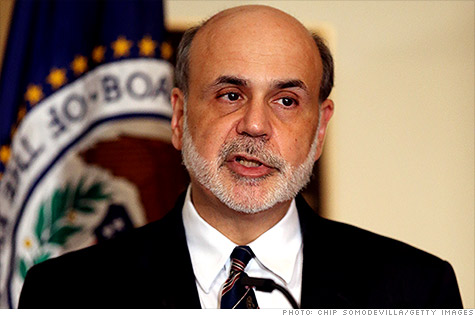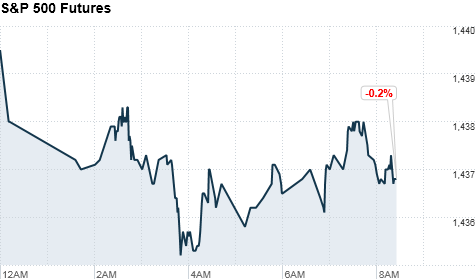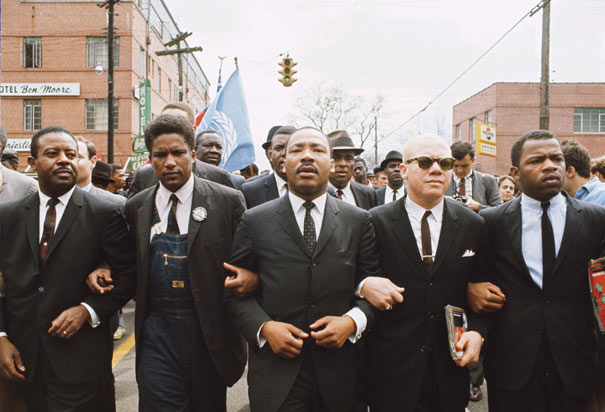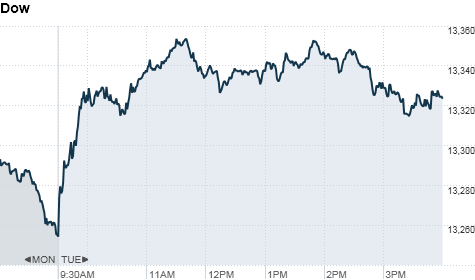Stop beating up the Rich
September 6, 2012: 5:00 AM ET
Instead of taking them down, shouldn't we figure out how to lift everyone up?
By Nina Easton, senior editor

FORTUNE
-- Alexis de Tocqueville famously chronicled American society's love of
equality -- and its equally passionate pursuit of money. "The love of
wealth," the French historian wrote in the 1840s, "is … at the bottom of
all that the Americans do." America stands out among Western nations
for its grudging, and often fawning, admiration for the wealthy classes
it produces. With the road to riches seemingly wide open, Americans
favor aspiration over resentment, envy over animus.
Except when they don't.
Rebellions against the rich are as much a part of the fabric of
American life as the Horatio Alger myth. One year ago this month, that
rebellion crystallized at lower Manhattan's Zuccotti Park, with the
start of a series of autumnal protests called
Occupy Wall Street.
During summer organizing meetings, anthropologist and former Yale
professor David Graeber had hit on a brilliant marketing formula for the
rebels: "Why not call ourselves the 99%?" he recalled asking fellow
plotters. "If 1% of the population have ended up with all the benefits
of the last 10 years of economic growth, control the wealth, own the
politicians … why not just say we're everybody else?"
In a hotly contested presidential election year, that formula found
easy political resonance. The 99% doesn't just mean the poor or the
unemployed or even the hardhat crowd. It includes the vast middle class
of blue collar and white collar and pink collar -- even the upper middle
class. It's the 99% that defined America's post-World War II economic
might and remains the target of any serious aspirant to the Oval Office.
With head-spinning speed, the 1%-99% divide entered the vocabulary of
journalists, politicians, and voters. More than ever in recent memory,
both a presidential election and
critical policy debates in Washington are being fought through this prism.
Sadly, it is a
confusing and flawed prism,
marred by hyperbole, half-truths, and unnecessary pessimism about what
it means to succeed in America. Yes, in politics, perceptions do matter.
Reports of CEOs making 231 times the average worker's pay, news of fat
Wall Street bonuses often unhinged from performance, and images of
executives flying to Washington on private jets to beg for bailouts feed
fears that the system is hopelessly rigged toward the rich and
powerful. But it's wrong to lump the 1% into a monolithic group of
greedy, tax-avoiding, selfish capitalists. They are a lot different from
what you might think.
MORE: Obama - a president ready for a showdown
Most of the 1.4 million taxpayers who make up the top 1% gained their
wealth through their own efforts rather than by inheritance. This group
consists of a large number of doctors, lawyers, engineers, and
small-time entrepreneurs, many of whom are working hard to create jobs.
To vilify them is the wrong debate. It's a conversation that tends to
cast blame on people who have made it to the top or anywhere near it,
since Obama's tax proposal labels as "wealthy" households making more
than $250,000 a year -- a comfortable income in Indianapolis (where the
median home price is $102,000) but barely enough to afford a studio
apartment in Manhattan, where tax rates easily hit 50%.
It's also a conversation that misses the point. Stirring resentment
and pitting Americans against one another distracts from the harder and
far more important conversation: how to
jump-start the escalator
for 23 million unemployed and underemployed -- and for those whose
incomes were stagnating well before the 2008 recession. Diatribes
against the 1% are provocative and entertaining, but they don't offer a
path to prosperity for those left behind in the global economy. If
Americans really understood who the 1% are, they would be more likely to
stop the name-calling and shift the debate to the dire task at hand --
getting millions back to work.
This isn't the first time an economic downturn has provoked
rebellions against the rich -- and it probably won't be the last. In the
depths of the Great Depression, F.D.R. surprised reporters and members
of Congress with a speech denouncing the "great accumulations of wealth"
and called for a surtax on the rich (which passed). There was political
calculation behind this. It was the summer of 1935, and F.D.R. faced a
threat to his reelection prospects from fiery populist Huey Long. The
Louisiana senator's Save Our Wealth campaign drew some 7 million
followers with a detailed program to cap wealth. Long's assassination
ended that electoral threat; F.D.R. would later joke about his
reputation for eating "grilled millionaire" for breakfast.

Half a century later, with the country pulling out of a relatively
mild recession, presidential candidate Bill Clinton noticed a front-page
New York Times headline shouting the 1980s: a very good time
for the very rich. The article asserted that the "richest 1% of American
families appears to have reaped most of the gains of the last decade
and a half " -- 60% of the wealth to be precise. Within days Clinton was
on the stump denouncing the "unfair gains of the rich" at the expense
of a "forgotten middle class." Eager to protect the image of the
Reagan-era boom times, President George H.W. Bush's administration went
on the offense to undermine the statistics used. But the damage was
done, and while the "1% club" didn't define the election as it does
today, Clinton became (in the words of the
Times) "one of the few presidential candidates since Truman to woo the middle class by pummeling the rich."
Ironically, wealth concentration would accelerate during Clinton's
own boom economy. But the media's characterization of wealth in the
1990s was far more benign than how they portrayed Reagan's greedy
"Gilded Age." That's only one of the many misperceptions that have
enshrouded a debate that has become as much emotional as economic.
It is true that today's wealthy are richer than in the past and their
share of the nation's income has grown. In the late 1970s and early
1980s, the 1% club earned about one-tenth of the nation's income. By
2007 it was 23.5%, the second highest in history after 1929. Cost of
admission to the 1% club varies from year to year, but when measured by
annual income it typically ranges between $300,000 and $400,000.
Net-worth estimates are less reliable and therefore seldom used, but by
one calculation, a household needs $8.4 million to qualify. About half
the 1% qualify in both categories.
MORE: Mitt Romney's 5-point plan for the economy
Are the rich, however, prospering at the expense of the middle class? As economists like to say,
it's not a zero-sum game.
Let's start with the fact that wealth concentration increases in boom
times and, ironically, was ebbing by the time Occupy Wall Street started
organizing. As Steven N. Kaplan, an economist at the University of
Chicago's Booth School of Business, notes, "Inequality in 2009 was
actually lower than at any time during Bill Clinton's second term."
During the booming 1990s inequality shot up -- but the middle class also
gained. In 1998 middle-class families enjoyed the largest one-year gain
in income since 1986, and poverty ticked down.
Over the past four decades the global economy has left many behind, but it has also lifted tens of millions
out of poverty.
In this more nuanced picture, those Americans with valued skills and
advanced educations are reaping the rewards. And here we're talking
about a swath of society well beyond the much-derided 1%: The top 20%
enjoyed strong gains since the late 1970s, and a new Pew Research Center
study found that 60% of Americans say their standard of living is
better than their parents' at the same age.
We hear a lot about a "shrinking" middle class. The Brookings
Institution's Scott Winship, who has done studies on mobility, says the
main reason is that people are moving up -- not down. Indeed,
upper-middle-income ranks have grown.
The Pew Research Center
finds that since the early 1980s middle-class Americans as a percentage
of the population fell from 61% to 51% -- and their median net worth
was flat. But the percentage of upper-income Americans surged from 14%
to 20% of the population.

The actual
number of millionaires
has also grown handily over the past decade. Although the number
dropped during the recession, it is slowly beginning to rebound. A 2011
study by the Deloitte Center for Financial Services found that over the
past decade the number of millionaire households rose from 7.7 million
to 10.5 million and predicts a doubling of American millionaires by
2020.
Another myth about the rich is that they are an exclusive club,
an entrenched plutocracy
that holds on to their fortunes generation after generation. In fact,
the wealth of the top 1% is notoriously volatile and drops precipitously
in recessions and depressions. (By one net-worth estimate, the
millionaire club had shrunk by 85% by the time F.D.R. started grilling
them.) Also, the membership rolls of the 1% club are always in flux.
According to a Federal Reserve study, between 1996 and 2005 some 57% of
the 1% fell out of the club.
Compare any list of today's wealthiest Americans with one of three
decades ago and what's striking is the rise of self-made men and women.
Studies show that most large accumulations of wealth today are earned,
not inherited. A 2008 survey by PNC Wealth Management found that 69% of
those with $500,000 or more in investable assets earned most of their
fortune through work, business ownership, or investments -- compared
with 6% who inherited their money. (Another 25% reported a combination
of earnings and inheritance.)
Regrettably, more wealth than ever in recent history comes not from
building companies but from the art of moving money around. The sloshes
of eye-popping salaries and bonuses on Wall Street unnerve the American
public --
and draw protests.
But even this fact deserves perspective. Finance constitutes only 13%
of the 1% club, according to a study by Williams College's Jon Bakija,
Indiana University's Bradley T. Heim, and the Treasury Department's Adam
Cole. The club also includes nonfinancial executives (30%), doctors
(14%), and lawyers (8%), as well as computer engineers, salespeople,
real estate traders, and, of course, celebrities in sports,
entertainment, and the media. In his book
Richistan, Robert Frank notes the prevalence of "stakeholders," entrepreneurs able to cash in when a company goes public.
MORE: Forget Washington - here's how we'd fix the economy
It's also worth noting that a rarely cited reason behind the phenomenon of the rich getting richer is
the success of women.
Beginning in the 1970s, more women began obtaining advanced degrees,
and making more money -- and then marrying men with similar achievement
levels. According to the Bakija-Heim-Cole study, among households in the
1%, those with a working spouse rose from 25.0% to 38.4% between 1979
and 2005. Type-A personality women tend to marry like-minded men --
social scientists dryly call it "assortative mating" -- and further skew
income at the top.
You may passionately believe that the 1% should pay more than the 40%
of federal income taxes they already contribute. You may think this is
the "fair" way to address a ballooning debt. Fine. But don't kid
yourself that there's enough money there to close the deficit -- and
raising taxes definitely won't cure inequality. You probably think the
average wealthy person pays lower tax rates. That's true for the
super-rich -- reflecting the lower taxes paid on investment income,
which typically makes up the bulk of their earnings. Hearing those
numbers infuriates average taxpayers. That's why the
so-called Buffett rule,
named for Warren Buffett, to impose a minimum 30% rate on
million-dollar incomes gained the White House's support -- and why in
public opinion polls proposals to increase taxes on the rich are hugely
popular.
When you look at the full picture, the average effective tax rate of
the 1% club in 2007 was 29.5%, which, according to the Congressional
Budget Office, is nearly twice that of the middle class. And nearly half
of all Americans -- those with low incomes -- don't pay a federal
income tax, though they do pay the regressive payroll tax and state and
local taxes. In other words, overall our progressive income tax code is
actually … progressive.

When you look beyond all the anti-rich rhetoric, what Americans really want is
more equal opportunity for themselves.
One reason behind the surge in wealth at the top is access to global
markets. Top American lawyers, bankers, consultants, and entrepreneurs
are playing on a wide turf and tapping into fast-growing emerging
markets. Rather than engaging in diatribes against them, we should be
asking how to build access lanes into that global economy for other
Americans. As Harvard economist Lawrence Katz has calculated, even if
Occupy Wall Street's wish came true and all the gains of the top 1%
since 1979 were confiscated and redistributed to the 99%, household
incomes would go up by less than half of what they would if everyone had
a college degree.
During the post-World War II decades, a period of extraordinary
income equality that economists label the Great Compression, Americans
had a relatively common and unifying set of incentives and values that
ultimately served the nation well through the tumult of the '60s and the
Vietnam War. Part of that shared value system was a deep-rooted belief
in social and economic mobility -- a belief powerfully articulated in
the presidency of Barack Obama, the biracial son of a single mom.
Today American upward mobility (especially for men) lags behind Canada's and some European nations'. The
decline in U.S. manufacturing
plays an obvious role. Men with high school diplomas have lost
high-paying jobs to factories in China and India and elsewhere. High
school dropouts, concentrated in inner cities, face even bleaker
prospects of getting ahead.
So the question is, How do we reboot an education system for a
21st-century workforce? In their landmark study on income inequality,
Harvard economists Claudia Goldin and Katz found that America's
educational attainment has slowed, especially compared with competitor
nations, at a time when technological advancement complicates
labor-force needs. Among OECD countries, the U.S. ranks near the bottom
in high school graduation rates and in the middle on college graduation
rates. We used to be at the top. "The slowdown and reversal [in the
U.S.] were so extreme that college graduation rates for young men born
in the mid-1970s are no higher than for those born in the late 1940s,"
the authors write.

Unfortunately,
there's a limit to what policymakers can do about the ravages on a
middle-aged man's job prospects after three decades' worth of
technological advances and global competition. But we can talk about
education:
College degrees,
while not a panacea, not only carry huge salary premiums but also offer
a measure of job protection. Last year's unemployment rate among the
college educated was 4.9%; among those with advanced degrees, it drops
to 2.4%. For those with high school diplomas it was 9.4%, and for those
without, 14%.
We can demand that corporate America invest more in the nation's workforce by
ramping up training programs.
Something is wrong when 3 million job openings are going unfilled, and
companies complain they can't find the right workers with the right
skills. We can ask how American communities can persuade businesses to
locate new offices and factories in their hometowns rather than in
places like China or Poland -- something corporate tax reform can help.
Harvard Business School professor Michael Porter, who runs studies of
U.S. competitiveness, is critical of executive compensation practices
and criticizes companies for a widespread failure to invest in the
American workforce. Nevertheless, he says, "it's not a good idea to
declare that people who are successful are bad. The better question is:
Do we have
a fair system for getting that education and skill? Are people unfairly handicapped? Are we doing enough to open the gateways?"
Mobility, in the form of equal opportunity rather than equal
outcomes, is rooted in the very idea of America -- and that's where the
public conversation over inequality needs to head. "If people never
think of themselves as moving up and out [of their circumstances], does
that then strike at pluralism, democracy, the heart of who we are?" asks
Harvard's Goldin. Our history suggests it's better to open the road to
riches for those Americans than to raid the gold pot at the end of it.
This story is from the September 24, 2012 issue of Fortune
.


 Is the third time the charm? Federal Reserve Chairman Ben
Bernanke certainly hopes so, as the central bank launched QE3 in an
attempt to stimulate the economy.
Is the third time the charm? Federal Reserve Chairman Ben
Bernanke certainly hopes so, as the central bank launched QE3 in an
attempt to stimulate the economy.
 NEW YORK (CNNMoney) -- The Federal Reserve's policymaking
committee is meeting for the next two days, and it is widely expected to
announce a third round of quantitative easing, known as QE3.
NEW YORK (CNNMoney) -- The Federal Reserve's policymaking
committee is meeting for the next two days, and it is widely expected to
announce a third round of quantitative easing, known as QE3.










